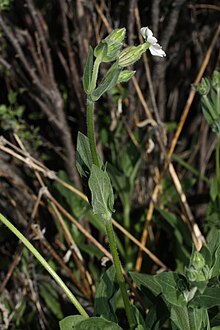White campion
| Silene latifolia | |
|---|---|
 |
|
| Scientific classification | |
| Kingdom: | Plantae |
| (unranked): | Angiosperms |
| (unranked): | Eudicots |
| (unranked): | Core eudicots |
| Order: | Caryophyllales |
| Family: | Caryophyllaceae |
| Genus: | Silene |
| Species: | S. latifolia |
| Binomial name | |
|
Silene latifolia Poir. |
|
| Synonyms | |
|
|
Silene latifolia (formerly Melandrium album), the white campion is a dioecious flowering plant in the family Caryophyllaceae, native to most of Europe, Western Asia and Northern Africa. It is a herbaceous annual, occasionally biennial or a short-lived perennial plant, growing to between 40-80 centimetres tall. It is also known in the USA as bladder campion but should not be confused with Silene vulgaris, which is more generally called Bladder Campion.
The appearance depends on the age of the plant; when young they form a basal rosette of oval to lanceolate leaves 4–10 cm long, and when they get older, forked stems grow from these, with leaves in opposite pairs. The flowers grow in clusters at the tops of the stems, 2.5–3 cm diameter, with a distinctive inflated calyx and five white petals, each petal deeply notched; flowering lasts from late spring to early autumn. The entire plant is densely hairy. Occasional plants with pink flowers are usually hybrids with red campion (Silene dioica).
White campion grows in most open habitats, particularly and fields, most commonly on neutral to alkaline soils. Despite the wide array of conditions in which campion can thrive, it prefers sunny areas that have rich and well-drained soil. An example ecoregion of occurrence is in the Sarmatic mixed forests.
It is also named the Grave Flower or Flower of the Dead in parts of England as they are seen often growing on gravesites and around tombstones.
It is naturalised in North America, being found in most of the United States, the greatest concentrations of the plant can be found in the north-central and northeastern sections of the country.S. latifolia is thought to have arrived in North America as a component of ship ballast.
...
Wikipedia
